Travel Through Yemen on a Harley-Davidson
By Peter & Kay Forwood
Yemen on a Harley (10/12/99 - 25/12/99)
Distance 2820 km (168510 km to 171330 km)
This is part of the Sixth section of our around the
world trip.
Complete Trip Overview & Map
Coming from Oman
 10/12/99 From the border to Al Ghayda on the Yemen coast,
260 km of new blacktop road built courtesy of the Oman government. The road
not yet finished with very short patches of gravel. Petrol was readily available
but we had to wait an hour in Hat (90 km into Yemen) until early afternoon
prayers had finished. An immediate difference apparent between the two countries,
the people darker and slighter built, the streets full of rubbish to the extent
20% of the main street was under dead shoes, plastic and cardboard, (no vegetable
matter as the cows were cleaning up their share) the people poorer and thus
unable to afford tidy or well washed clothes. Yet the atmosphere was friendly
and helpful. After much discussion with truck drivers, Bedouin, travellers
and locals through an english speaking ex policeman (having just finished
two years compulsory service between school and work or university) we deduced
that the coast road to Sayhut, our intended route, had about 50 km of sand
and only 4x4 vehicles travelled that way. The much longer section of dirt
(450 km as opposed to 250 km along the coast) was to head to Tamrin in Wadi
Hadramaut, a busier though bumpy gravel road without a lot of sand. The problem
on this road though are the many unsignposted intersections and a guide was
suggested.
10/12/99 From the border to Al Ghayda on the Yemen coast,
260 km of new blacktop road built courtesy of the Oman government. The road
not yet finished with very short patches of gravel. Petrol was readily available
but we had to wait an hour in Hat (90 km into Yemen) until early afternoon
prayers had finished. An immediate difference apparent between the two countries,
the people darker and slighter built, the streets full of rubbish to the extent
20% of the main street was under dead shoes, plastic and cardboard, (no vegetable
matter as the cows were cleaning up their share) the people poorer and thus
unable to afford tidy or well washed clothes. Yet the atmosphere was friendly
and helpful. After much discussion with truck drivers, Bedouin, travellers
and locals through an english speaking ex policeman (having just finished
two years compulsory service between school and work or university) we deduced
that the coast road to Sayhut, our intended route, had about 50 km of sand
and only 4x4 vehicles travelled that way. The much longer section of dirt
(450 km as opposed to 250 km along the coast) was to head to Tamrin in Wadi
Hadramaut, a busier though bumpy gravel road without a lot of sand. The problem
on this road though are the many unsignposted intersections and a guide was
suggested.
11/12/99 Al Ghayda is really just an overgrown fishing
village in the middle of nowhere. Sardines the main catch, along with shark
and reef fish are netted from narrow 12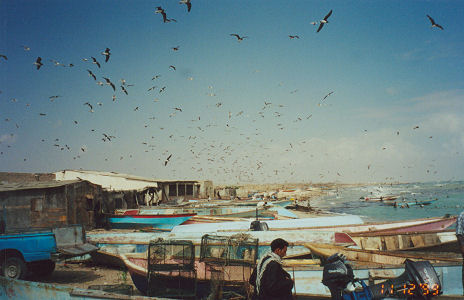 metre long boats. The sardines are then dried under hectares of nets to
keep away thousands of seagulls. Unfortunately its location means that the
sardines are only useful for stock feed as a protein supplement. On our return
to the hotel we discovered someone had been in our room and rummaged through
our bags. Nothing that we could identify was missing. Whether it was inquisitive
hotel staff or the local police we will never know. We reported the matter
to the management to his surprise and disbelief.
metre long boats. The sardines are then dried under hectares of nets to
keep away thousands of seagulls. Unfortunately its location means that the
sardines are only useful for stock feed as a protein supplement. On our return
to the hotel we discovered someone had been in our room and rummaged through
our bags. Nothing that we could identify was missing. Whether it was inquisitive
hotel staff or the local police we will never know. We reported the matter
to the management to his surprise and disbelief.
12/12/99 We opted for the inland route without
a guide and within six km of town had taken a wrong turn. On the right track
it was only another 15 km before the motorcycle started playing up, missing
and backfiring. We suspected water in the fuel and cleaned the carburettor.
It was still occurring so another 15 km we stopped again and disconnected
the tachometer and checked some wiring from previous problems. Another 10
km and still a problem, the third stop and located an electrical problem.
The rough road had bounced the engine and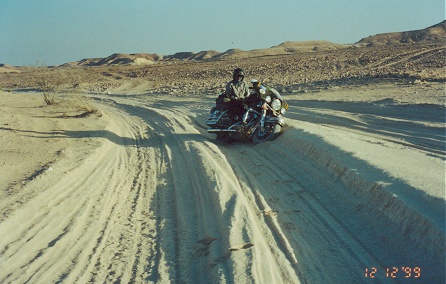 pulled on some wires leading to the timing case, these were
strapped tighter for later repair and the problem was solved, 40 km out and
four hours later. The unmade track across wadi (river) beds would branch
off into about six different directions when the corrugations became bad
or the sand became too chopped up returning again to one or two tracks across
gullies. Kay's job was to watch all the diverging tracks to make sure they
rejoined and we didn't miss a turn off. We were unable to get up enough speed
to skim across the corrugations as the tracks were too rough and were then
limited to 30-40 km/hr dodging and weaving ruts and to a crawl across rocky
sections. We ran off the track once and became hopelessly bogged in
sand, needing to roll the motorcycle on its side and drag the front wheel
around back onto the track. With Kay pushing and the belt slipping from
the sand lodged in the grooves we managed to drive the rear wheel out of
the sand. About every 80 km there is a settlement, petrol and small shop
(shop closed during daylight for Ramadan) where we could check we
pulled on some wires leading to the timing case, these were
strapped tighter for later repair and the problem was solved, 40 km out and
four hours later. The unmade track across wadi (river) beds would branch
off into about six different directions when the corrugations became bad
or the sand became too chopped up returning again to one or two tracks across
gullies. Kay's job was to watch all the diverging tracks to make sure they
rejoined and we didn't miss a turn off. We were unable to get up enough speed
to skim across the corrugations as the tracks were too rough and were then
limited to 30-40 km/hr dodging and weaving ruts and to a crawl across rocky
sections. We ran off the track once and became hopelessly bogged in
sand, needing to roll the motorcycle on its side and drag the front wheel
around back onto the track. With Kay pushing and the belt slipping from
the sand lodged in the grooves we managed to drive the rear wheel out of
the sand. About every 80 km there is a settlement, petrol and small shop
(shop closed during daylight for Ramadan) where we could check we were still heading in the right direction. Eleven
hours sunrise to sunset, 240 km we camped roadside absolutely stuffed.
were still heading in the right direction. Eleven
hours sunrise to sunset, 240 km we camped roadside absolutely stuffed.
13/12/99 The morning desert is so quiet all you can hear
is your own tinnitus. While relieving myself I pondered being the first
western person to urinate on this spot, at least the first having arrived
by Harley-Davidson motorcycle. Our first stop just 30 km at Dhabaat and the
wadi ended and the long sandy plain began with everyone seemingly making
their own tracks around the more sandy boggy sections broadening the track
to hundreds of meters wide. We came off a few times and Kay pushed and walked,
then we rode some, then Kay pushed and walked. The "bull dust" (soft powdery
fluffy talc like dirt) deep and settled over rocky ground meaning we couldn't
see the rocks bottoming a couple of times. This finally ended at Guful where
the road descended over a distance of 25 km off the plateau and into the
far end of Wadi Hadramaut. The whole 25 km was down a gorge, the track
made of large rocks with barely a path for the two wheels of the motorcycle without bottoming which we did many times, once smashing
the bash plate which we removed and smashed back into shape with rocks and
once denting the tubular frame of the motorcycle but luckily missing damaging
any vital parts. Once in the wadi the dirt more manageable and even black
top the last 35 km's to Say'un for the night. 420 km dirt, 14 hours riding
time, hot and dusty, by far the worst road we have ridden. An off road bike
with no pillion would certainly have made easier going and would probably
manage it in one long day.
without bottoming which we did many times, once smashing
the bash plate which we removed and smashed back into shape with rocks and
once denting the tubular frame of the motorcycle but luckily missing damaging
any vital parts. Once in the wadi the dirt more manageable and even black
top the last 35 km's to Say'un for the night. 420 km dirt, 14 hours riding
time, hot and dusty, by far the worst road we have ridden. An off road bike
with no pillion would certainly have made easier going and would probably
manage it in one long day.
14/12/99 It is certainly frontier country in the east
of Yemen, many men carry Kalashnikov rifles with them at all times, others
carry hand guns strapped to waist belts and covered by long shirts over traditional
wrap around pants (loin cloth, sarong) and a few still carry the Jambiya or
dagger worn in front of the body on the belt. Our hotel has a sign in the
lobby that all weapons must be left at reception. Jeans, infiltrated into
most traditional societies, have yet to make any impact here. The people,
that pleasant blend of interest without overbearing. We can happily work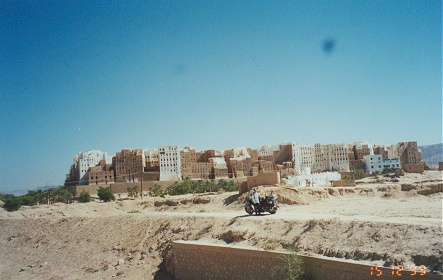 on the motorcycle or sit quietly over a tea in the souk
with a balance of interaction/privacy. Women are nowhere to be seen, representing
less than a fraction of 1% of people visible. Rested in Say'un
on the motorcycle or sit quietly over a tea in the souk
with a balance of interaction/privacy. Women are nowhere to be seen, representing
less than a fraction of 1% of people visible. Rested in Say'un
15/12/99 This area of Yemen is famous for its mud brick
tower houses. We visited old Shibam, a collection of about 500 mud brick
sky scrapers five to eight stories high crammed into an area 500 meters square
with narrow streets and mosques up to 1000 years old. Even today most buildings
here are still made in this unique style of mud brick. The more wealthy plaster
their houses with white limestone and outline it with an even whiter egg shell
plaster.
16/12/99 Out and back to Tarim, the city of 365 mosques
and many palaces now in disrepair as the owners fled to Saudi Arabia when
this area of Yemen came under communist rule. Hassled again by children,
prying to look at the motorcycle and a couple of stones were thrown at us
and rude gestures made. It's amazing how such obnoxious children can grow up into
friendly respectful adults.
gestures made. It's amazing how such obnoxious children can grow up into
friendly respectful adults.
17/12/99 After having ridden 1000 km in Yemen the bureaucracy
finally caught up with us. We left Say'un early and rode out of Wadi Hadramaut
to Al Mukulla, a fast growing coastal town with a picturesque old fishing
town at its centre. 30 km's further towards Aden and 2 pm we were stopped
at a security post and amazed guards wouldn't let us past. They led us back
the 30 km's to Al Mukulla police compound and after a couple of hours of firm
polite discussion we were allowed to proceed with an armed escort and permit
papers. The 70 km's from Barum to Bir 'Ali was supposed to be a no go area
after dark but with the end of the days fasting at sunset we stopped midway
and joined our entourage of eight in sweet dates and pastries. It was well
dark when we arrived in Bir 'Ali and we were officially handed over to the
governorate of Shabwa. A small coastal town with no hotel we were allowed/encouraged
to pitch the tent on the roof 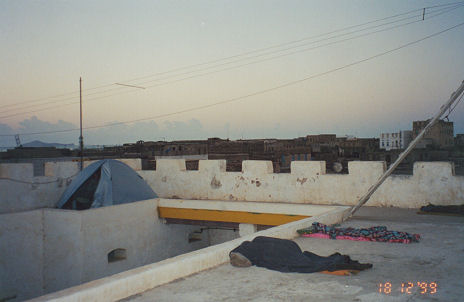 of the police fort, a dilapidated building having seen no repair since unification
or long before.
of the police fort, a dilapidated building having seen no repair since unification
or long before.
18/12/99 Now in the grip of escorts we left at 6.30 am
this time following, a Toyota 4x4, with machine gun turret mounted on the
tray, five of them and two of us. We had not eaten since the night before
having slept while they ate during the night so headed into the bushes out
of sight (it being Ramadan), to eat breakfast and toilet. After a couple
of hundred kilometres, near Habban we were handed over to the next escort
to Ataq. Here for two hours at the police compound, (phone calls, questioning)
and another escort to Bayhan. It was now 2 pm and they wanting us to stay
the night here and we were wanting to leave for Mahrib. Again two and a
half hours of discussions and phone calls (at one stage they wanted to send
us back to Ataq) before they produced a permit to proceed to Harib, a small
town just over the border in the governorate of Mahrib, more modern being
from the north before unification (capitalist rather than communist in the
south).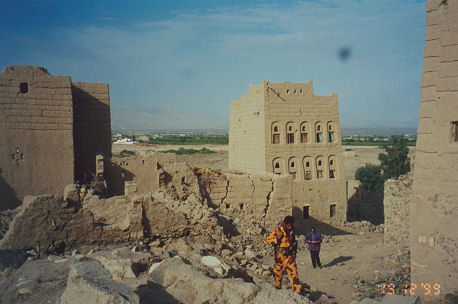 A warm welcome and again we ate the end of fast meal and a late meal before
retiring to a room on the fort roof.
A warm welcome and again we ate the end of fast meal and a late meal before
retiring to a room on the fort roof.
19/12/99 6 am and we were away again with another escort
to Mahrib. A quick look at old Mahrib, blown up during the 1960's war, the
old dam originally built in 800 BC and lasted for over 1000 years reportedly
during the Queen of Sheba's reign and the new dam built only a few years ago.
Accompanied again by another escort this time also carrying an anti tank
bazooka along with its other weaponry. After almost 1000 km of being escorted
we were finally released on the Sana'a road about 80 km from the town. The
cost of this protection to us, and hospitality, officially nothing, unofficially,
small money for cigarettes and qat (the mild stimulant almost every man in
Yemen chews, similar to chewing the coca leaf, consuming a large part of
his income and the countries agricultural production). Some escorts refused
any money at all, others demanded it almost, but most were just happy for a boost to their meagre police wages. We arrived in Sana'a
exhausted after this rush, rush across the country.
a boost to their meagre police wages. We arrived in Sana'a
exhausted after this rush, rush across the country.
20/12/99 With the borders still closed between Sudan and
Ethiopia and Eritrea the only access being by boat in and out we opted to
miss Sudan and Eritrea, travelling through Africa from Djibouti to Ethiopia
and Kenya. The Djibouti visa issued in three hours, Ethiopia 24 hours, collect
tomorrow and the Kenyan one issued at the British embassy in three hours tomorrow.
This took the majority of the day to achieve, being ferried about by local
taxi's. I think I will have to change my rating for the worlds worst drivers
to Yemen. Every vehicle has multiple scrapes and dents, taxi's are identifiable
because there isn't a panel on the car that isn't dented and the bumper bars
are usually half ripped off, the indicators and brake lights don't work nor
is there much plastic covering them. Our escort yesterday needed petrol so
he overtook us then swerved in front braking hard running us onto the shoulder.
To avoid hitting him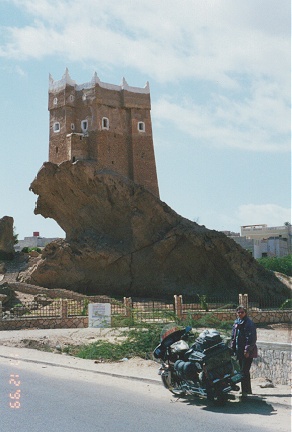 we braked hard swerved onto gravel and went down. Our first
down on asphalt since India two years ago, in about the same circumstances,
someone swerving in front.
we braked hard swerved onto gravel and went down. Our first
down on asphalt since India two years ago, in about the same circumstances,
someone swerving in front.
21/12/99 Sana'a, despite the rubbish and noise, has to
be one of the most appealing and attractive capital cities. The old city
still mostly authentic tower houses of stone with white highlights and coloured
glass windows, narrow streets and souqs can occupy hours of walking, sitting
and watching. An old wadi runs down it's middle, a road when dry and a river
when it rains.
22/12/99 Into the surroundings with their stone housed
villages and stone terraced fields agriculture, to Kawkaban, an escape town
perched on a peninsula 300 meters above the main town and its agriculture.
When warring parties would try and conquer the main town the people would
escape to the fortress town for protection. Never conquered until the advent
of aeroplane bombing in the 1960's. We stayed the night in a traditional
stone tower house in the stone village of Thilla. Originally built with animals
on the ground floor, stock feed on the second, living quarters on the next
two and a mafraj (living or guest room) on the top floor. High ceilings with
low doors and walls up to a meter thick.
23/12/99 Sana'a to Manakha and over the mountains. Although
fertile these treeless mountains in winter without crops in the terraced
fields look barren. Lucked into a more traditional lunch provided for about
40 elderly German passengers from a cruise ship on a days outing to the mountains.
With hot bread, cooked local vegetable and meat, stuffed with food we headed
for Al Hudayda, on the west coast for the night, we had made it from east
to west on the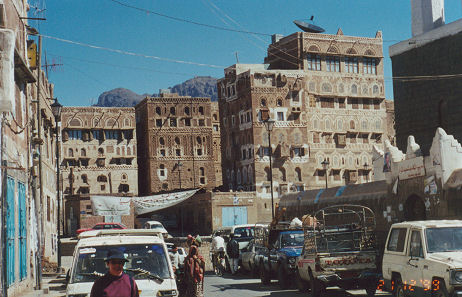 Arabian Peninsula.
Arabian Peninsula.
24/12/99 Coming out of the mountains to the west coast
and we could have been in Africa such was its influence on the appearance
of the people, their clothing and the round mud and grass roofed huts in
the more fertile coastal belt. This was even more strongly felt at the Friday
markets in Bait al Fakih, famous in Yemen, and the most active we have seen.
Arriving as it was getting under way and watching it grow, 4x4's and pickups
arrived by the hundreds along with camels, donkeys and goats, sorghum grass
from the sandy flat lands and anything else that could be sold including prostitutes,
fully robed, manoeuvring to drop the veil to a prospective client without
being seen by more respectable/prudish members of the society. Qat was of
course here, as everywhere, despite its only being grown in the mountains
and used fresh daily. The wind increased to gale force on entering Al Makha
a desolate place far from its former glory as the coffee hub of the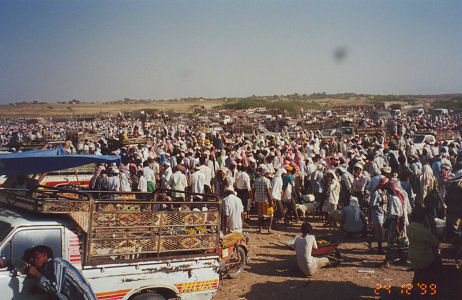 world (Mocha coffee still carrying the name), the sand blowing across the
road through town. We were here only for a boat to Djibouti and spread the
word at the port and in town. The strong winds had prevented a sambuq (30
meter long wooden boat) from leaving harbour for Djibouti for the last two
days and after four hours of negotiations between the captain (on the boat)
and the agent (chewing qat with his mates in town) and many rip off motorcycle
taxi rides between the two (as the monopoly prevented any private vehicles
on the wharf) the original $US 800.00 price was reduced to $US 200.00. Still
expensive but as the boat had to be brought back alongside the wharf and the
motorcycle specially craned aboard the all inclusive price with meals was
acceptable. At 11 pm we went to the port to begin paperwork.
world (Mocha coffee still carrying the name), the sand blowing across the
road through town. We were here only for a boat to Djibouti and spread the
word at the port and in town. The strong winds had prevented a sambuq (30
meter long wooden boat) from leaving harbour for Djibouti for the last two
days and after four hours of negotiations between the captain (on the boat)
and the agent (chewing qat with his mates in town) and many rip off motorcycle
taxi rides between the two (as the monopoly prevented any private vehicles
on the wharf) the original $US 800.00 price was reduced to $US 200.00. Still
expensive but as the boat had to be brought back alongside the wharf and the
motorcycle specially craned aboard the all inclusive price with meals was
acceptable. At 11 pm we went to the port to begin paperwork.
25/12/99 Midnight passed and Christmas day began as we
waited with the immigration official who had five people to process all
night and was determined it would take all night. He had watched too many
American movies where obviously why would we be at his port unless there was something wrong.
Customs was as bad and between the three officials in three separate buildings
none wanting to be the first to sign our forms. It wasn't until presumably
the mafia arrived (flash 4x4 with two heavily armed body guards plus entourage)
that our paperwork was completed four hours after starting. (Al Makha is
now supposed to be the major whisky smuggling port for Yemen). The motorcycle
was craned aboard and we settled down to a tarp covered wooden plank on top
of the cargo of cardboard boxed goods at 3 am. I would not recommend this
port for departure but suggest trying Aden first if possible. At 6.30 am
the 30 meter boat, cargo, bike, 20 crew and five passengers headed out of
the harbour into strong head winds hugging the Yemen coast to the south west
corner where at 8.30 pm we anchored for the night having travelled just 80
km.
where obviously why would we be at his port unless there was something wrong.
Customs was as bad and between the three officials in three separate buildings
none wanting to be the first to sign our forms. It wasn't until presumably
the mafia arrived (flash 4x4 with two heavily armed body guards plus entourage)
that our paperwork was completed four hours after starting. (Al Makha is
now supposed to be the major whisky smuggling port for Yemen). The motorcycle
was craned aboard and we settled down to a tarp covered wooden plank on top
of the cargo of cardboard boxed goods at 3 am. I would not recommend this
port for departure but suggest trying Aden first if possible. At 6.30 am
the 30 meter boat, cargo, bike, 20 crew and five passengers headed out of
the harbour into strong head winds hugging the Yemen coast to the south west
corner where at 8.30 pm we anchored for the night having travelled just 80
km.
Move with us to Djibouti
 10/12/99 From the border to Al Ghayda on the Yemen coast,
260 km of new blacktop road built courtesy of the Oman government. The road
not yet finished with very short patches of gravel. Petrol was readily available
but we had to wait an hour in Hat (90 km into Yemen) until early afternoon
prayers had finished. An immediate difference apparent between the two countries,
the people darker and slighter built, the streets full of rubbish to the extent
20% of the main street was under dead shoes, plastic and cardboard, (no vegetable
matter as the cows were cleaning up their share) the people poorer and thus
unable to afford tidy or well washed clothes. Yet the atmosphere was friendly
and helpful. After much discussion with truck drivers, Bedouin, travellers
and locals through an english speaking ex policeman (having just finished
two years compulsory service between school and work or university) we deduced
that the coast road to Sayhut, our intended route, had about 50 km of sand
and only 4x4 vehicles travelled that way. The much longer section of dirt
(450 km as opposed to 250 km along the coast) was to head to Tamrin in Wadi
Hadramaut, a busier though bumpy gravel road without a lot of sand. The problem
on this road though are the many unsignposted intersections and a guide was
suggested.
10/12/99 From the border to Al Ghayda on the Yemen coast,
260 km of new blacktop road built courtesy of the Oman government. The road
not yet finished with very short patches of gravel. Petrol was readily available
but we had to wait an hour in Hat (90 km into Yemen) until early afternoon
prayers had finished. An immediate difference apparent between the two countries,
the people darker and slighter built, the streets full of rubbish to the extent
20% of the main street was under dead shoes, plastic and cardboard, (no vegetable
matter as the cows were cleaning up their share) the people poorer and thus
unable to afford tidy or well washed clothes. Yet the atmosphere was friendly
and helpful. After much discussion with truck drivers, Bedouin, travellers
and locals through an english speaking ex policeman (having just finished
two years compulsory service between school and work or university) we deduced
that the coast road to Sayhut, our intended route, had about 50 km of sand
and only 4x4 vehicles travelled that way. The much longer section of dirt
(450 km as opposed to 250 km along the coast) was to head to Tamrin in Wadi
Hadramaut, a busier though bumpy gravel road without a lot of sand. The problem
on this road though are the many unsignposted intersections and a guide was
suggested.  metre long boats. The sardines are then dried under hectares of nets to
keep away thousands of seagulls. Unfortunately its location means that the
sardines are only useful for stock feed as a protein supplement. On our return
to the hotel we discovered someone had been in our room and rummaged through
our bags. Nothing that we could identify was missing. Whether it was inquisitive
hotel staff or the local police we will never know. We reported the matter
to the management to his surprise and disbelief.
metre long boats. The sardines are then dried under hectares of nets to
keep away thousands of seagulls. Unfortunately its location means that the
sardines are only useful for stock feed as a protein supplement. On our return
to the hotel we discovered someone had been in our room and rummaged through
our bags. Nothing that we could identify was missing. Whether it was inquisitive
hotel staff or the local police we will never know. We reported the matter
to the management to his surprise and disbelief.  pulled on some wires leading to the timing case, these were
strapped tighter for later repair and the problem was solved, 40 km out and
four hours later. The unmade track across wadi (river) beds would branch
off into about six different directions when the corrugations became bad
or the sand became too chopped up returning again to one or two tracks across
gullies. Kay's job was to watch all the diverging tracks to make sure they
rejoined and we didn't miss a turn off. We were unable to get up enough speed
to skim across the corrugations as the tracks were too rough and were then
limited to 30-40 km/hr dodging and weaving ruts and to a crawl across rocky
sections. We ran off the track once and became hopelessly bogged in
sand, needing to roll the motorcycle on its side and drag the front wheel
around back onto the track. With Kay pushing and the belt slipping from
the sand lodged in the grooves we managed to drive the rear wheel out of
the sand. About every 80 km there is a settlement, petrol and small shop
(shop closed during daylight for Ramadan) where we could check we
pulled on some wires leading to the timing case, these were
strapped tighter for later repair and the problem was solved, 40 km out and
four hours later. The unmade track across wadi (river) beds would branch
off into about six different directions when the corrugations became bad
or the sand became too chopped up returning again to one or two tracks across
gullies. Kay's job was to watch all the diverging tracks to make sure they
rejoined and we didn't miss a turn off. We were unable to get up enough speed
to skim across the corrugations as the tracks were too rough and were then
limited to 30-40 km/hr dodging and weaving ruts and to a crawl across rocky
sections. We ran off the track once and became hopelessly bogged in
sand, needing to roll the motorcycle on its side and drag the front wheel
around back onto the track. With Kay pushing and the belt slipping from
the sand lodged in the grooves we managed to drive the rear wheel out of
the sand. About every 80 km there is a settlement, petrol and small shop
(shop closed during daylight for Ramadan) where we could check we were still heading in the right direction. Eleven
hours sunrise to sunset, 240 km we camped roadside absolutely stuffed.
were still heading in the right direction. Eleven
hours sunrise to sunset, 240 km we camped roadside absolutely stuffed.
 without bottoming which we did many times, once smashing
the bash plate which we removed and smashed back into shape with rocks and
once denting the tubular frame of the motorcycle but luckily missing damaging
any vital parts. Once in the wadi the dirt more manageable and even black
top the last 35 km's to Say'un for the night. 420 km dirt, 14 hours riding
time, hot and dusty, by far the worst road we have ridden. An off road bike
with no pillion would certainly have made easier going and would probably
manage it in one long day.
without bottoming which we did many times, once smashing
the bash plate which we removed and smashed back into shape with rocks and
once denting the tubular frame of the motorcycle but luckily missing damaging
any vital parts. Once in the wadi the dirt more manageable and even black
top the last 35 km's to Say'un for the night. 420 km dirt, 14 hours riding
time, hot and dusty, by far the worst road we have ridden. An off road bike
with no pillion would certainly have made easier going and would probably
manage it in one long day.  on the motorcycle or sit quietly over a tea in the souk
with a balance of interaction/privacy. Women are nowhere to be seen, representing
less than a fraction of 1% of people visible. Rested in Say'un
on the motorcycle or sit quietly over a tea in the souk
with a balance of interaction/privacy. Women are nowhere to be seen, representing
less than a fraction of 1% of people visible. Rested in Say'un  gestures made. It's amazing how such obnoxious children can grow up into
friendly respectful adults.
gestures made. It's amazing how such obnoxious children can grow up into
friendly respectful adults.  of the police fort, a dilapidated building having seen no repair since unification
or long before.
of the police fort, a dilapidated building having seen no repair since unification
or long before.  A warm welcome and again we ate the end of fast meal and a late meal before
retiring to a room on the fort roof.
A warm welcome and again we ate the end of fast meal and a late meal before
retiring to a room on the fort roof.  a boost to their meagre police wages. We arrived in Sana'a
exhausted after this rush, rush across the country.
a boost to their meagre police wages. We arrived in Sana'a
exhausted after this rush, rush across the country.  we braked hard swerved onto gravel and went down. Our first
down on asphalt since India two years ago, in about the same circumstances,
someone swerving in front.
we braked hard swerved onto gravel and went down. Our first
down on asphalt since India two years ago, in about the same circumstances,
someone swerving in front.  Arabian Peninsula.
Arabian Peninsula.  world (Mocha coffee still carrying the name), the sand blowing across the
road through town. We were here only for a boat to Djibouti and spread the
word at the port and in town. The strong winds had prevented a sambuq (30
meter long wooden boat) from leaving harbour for Djibouti for the last two
days and after four hours of negotiations between the captain (on the boat)
and the agent (chewing qat with his mates in town) and many rip off motorcycle
taxi rides between the two (as the monopoly prevented any private vehicles
on the wharf) the original $US 800.00 price was reduced to $US 200.00. Still
expensive but as the boat had to be brought back alongside the wharf and the
motorcycle specially craned aboard the all inclusive price with meals was
acceptable. At 11 pm we went to the port to begin paperwork.
world (Mocha coffee still carrying the name), the sand blowing across the
road through town. We were here only for a boat to Djibouti and spread the
word at the port and in town. The strong winds had prevented a sambuq (30
meter long wooden boat) from leaving harbour for Djibouti for the last two
days and after four hours of negotiations between the captain (on the boat)
and the agent (chewing qat with his mates in town) and many rip off motorcycle
taxi rides between the two (as the monopoly prevented any private vehicles
on the wharf) the original $US 800.00 price was reduced to $US 200.00. Still
expensive but as the boat had to be brought back alongside the wharf and the
motorcycle specially craned aboard the all inclusive price with meals was
acceptable. At 11 pm we went to the port to begin paperwork.  where obviously why would we be at his port unless there was something wrong.
Customs was as bad and between the three officials in three separate buildings
none wanting to be the first to sign our forms. It wasn't until presumably
the mafia arrived (flash 4x4 with two heavily armed body guards plus entourage)
that our paperwork was completed four hours after starting. (Al Makha is
now supposed to be the major whisky smuggling port for Yemen). The motorcycle
was craned aboard and we settled down to a tarp covered wooden plank on top
of the cargo of cardboard boxed goods at 3 am. I would not recommend this
port for departure but suggest trying Aden first if possible. At 6.30 am
the 30 meter boat, cargo, bike, 20 crew and five passengers headed out of
the harbour into strong head winds hugging the Yemen coast to the south west
corner where at 8.30 pm we anchored for the night having travelled just 80
km.
where obviously why would we be at his port unless there was something wrong.
Customs was as bad and between the three officials in three separate buildings
none wanting to be the first to sign our forms. It wasn't until presumably
the mafia arrived (flash 4x4 with two heavily armed body guards plus entourage)
that our paperwork was completed four hours after starting. (Al Makha is
now supposed to be the major whisky smuggling port for Yemen). The motorcycle
was craned aboard and we settled down to a tarp covered wooden plank on top
of the cargo of cardboard boxed goods at 3 am. I would not recommend this
port for departure but suggest trying Aden first if possible. At 6.30 am
the 30 meter boat, cargo, bike, 20 crew and five passengers headed out of
the harbour into strong head winds hugging the Yemen coast to the south west
corner where at 8.30 pm we anchored for the night having travelled just 80
km.